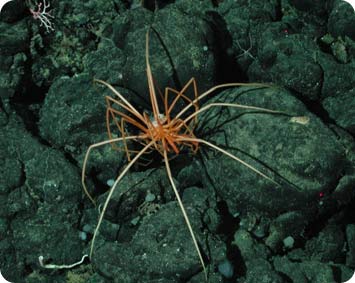When is a spider not really a spider? When it’s scuttling along the bottom of the sea.
Biologists have discovered more than a thousand species of sea spiders. They look a lot like their terrestrial cousins, with lots of gangly legs extending from a slender body. But they’re not true spiders. Instead, they’re probably distant cousins -- perhaps a part of the group that branched off tens of millions of years ago.
 Sea spiders have lots of gangly legs and a slender body. Credit: National Oceanic and Atmospheric Administration
Sea spiders have lots of gangly legs and a slender body. Credit: National Oceanic and Atmospheric AdministrationSea spiders are found around the world, from the tropics to the Arctic and Antarctic, and from shallow coastal waters to the deep ocean.
Most of them are tiny -- less than an inch across. But a few are giants -- up to three feet from leg tip to leg tip. The big ones are usually found at greater depths.
One difference from land spiders is that sea spiders don’t have much of a body -- they’re almost all legs. In fact, much of their internal organs are contained in the legs.
What little body they do have consists of narrow segments with one or more pair of legs. Most species have eight legs for walking, but some have 10 or 12. Most also have some extra appendages. Males, for example, have special “legs” for carrying eggs and newly hatched juveniles.
Sea spiders generally feed through a long, tube-like structure known as a proboscis, which is similar to the feeding tubes used by butterflies. The spider inserts the proboscis into a sea anemone or other bottom dweller and sucks out the tasty juices. So while a sea spider may not be a true spider, it’s just as creepy.

